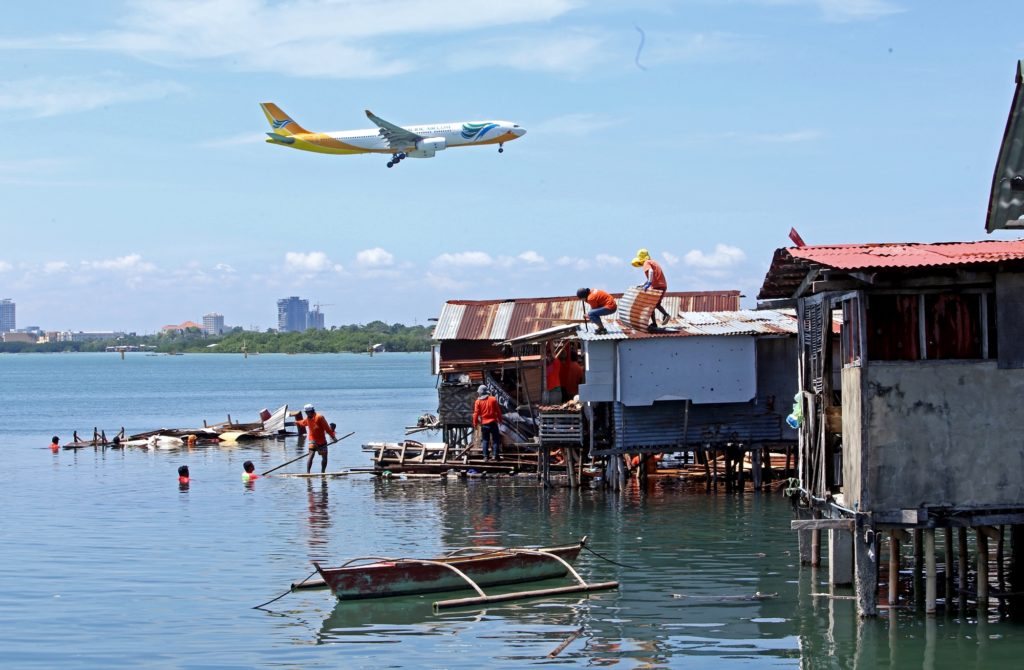Nearly 100 coastal structures demolished, 600 more to go

DEMOLITION CREW from Lapu-Lapu City tear down the houses that are built almost in the middle of the sea off Barangay Ibo, facing the Mactan Channel, on June 13, 2018.
FOR ten years, their house that stood on the seashore of Barangay Ibo in Lapu-Lapu City has been the home and source of income for the Felescuso family.
Hansel Felescuso, 55, earned P4,000 from the rental of the four boarders that he accommodated in the extension of his house.
Felescuso, who works as a security guard, said that this amount has been of great help in sending his two sons to school, his eldest being a computer engineering student.
But now, Felescuso and his family neither have a home nor a boarding house.
Despite some verbal tussle, the demolition of houses along the shorelines of Barangay Ibo in Lapu-Lapu City was carried out yesterday.
Nearly 100 houses and some piggeries were torn down by the demolition team composed of personnel from the Lapu-Lapu City Clean and Green, Material
Recovery Facility, and Engineering departments.
Mayor Paz Radaza personally supervised the demolition as she appealed to some of the residents to voluntarily take down their houses.
The massive clearing operation involved around 260 city personnel secured by about 40 of the city’s policemen.
However, some residents complained that the demolition team could not just tear down their structures without providing them with a relocation site.
Radaza explained the city is still on the process of acquiring a private lot for the socialized housing, which is a part of the project of President Rodrigo Duterte to bring in investors for the creation of medium-rise condominiums available for Community Mortgage Program.
The Lapu-lapu City government also gave a P10,000 cash assistance to each household. The demolition of the illegal structures will continue until late next week.
According to Radaza, there are about 600 houses, rented rooms and 60 piggeries in Barangays Ibo, Buaya, Mactan, Pusok and Pajo that are set to be taken down.
The demolition stemmed from the findings of the Environmental Management Bureau (EMB-7) that the amount of fecal coliform present in the waters off Mactan was beyond the standard of 100 Most Probable Number (mpn) per 100 milliliters.
William Cuñado, EMB-7 director, said that the quality of the waters off Mactan has dramatically improved but has still to meet the safety standard.
“In the month of May, we’ve only recorded the highest at around 170 mpn per 100 ml for fecal coliform contamination,” said Cuñado.
Meanwhile, Department of Environment and Natural Resources in Central Visayas (DENR-7) Director Gilbert Gonzales commended the efforts of the Lapu-Lapu City government and urged other local government units (LGUs) to do the same.
He said that the LGUs should be keen in assuring that structures within their jurisdictions should observe the easement requirement set by the Water Code of the Philippines.
“We have openly informed not only the concerned LGUs, but everybody in the region on the provisions of the Water Code of the Philippines which defines the easement zones. So our intention is actually to make them aware that these easement zones should be left open,” said Gonzales.
The easement in cities should be not less than 3 meters; 20 meters in agricultural locales; and 40 meters for timber lands. /WITH CORRESPONDENT NORMAL V. MENDOZA
Disclaimer: The comments uploaded on this site do not necessarily represent or reflect the views of management and owner of Cebudailynews. We reserve the right to exclude comments that we deem to be inconsistent with our editorial standards.
